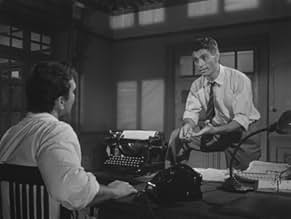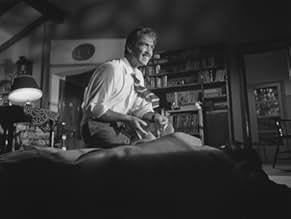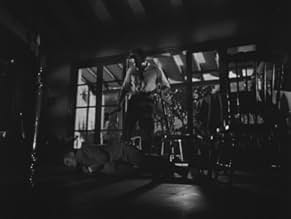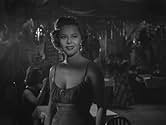Añade un argumento en tu idiomaA washed up reporter teams up with an immigrant from Hungary to start a fake journalism by correspondence school.A washed up reporter teams up with an immigrant from Hungary to start a fake journalism by correspondence school.A washed up reporter teams up with an immigrant from Hungary to start a fake journalism by correspondence school.
- Dirección
- Guión
- Reparto principal
- Premios
- 2 premios en total
Otto Webber
- Noriega
- (as Otto Weber)
George Hilton
- Hombre en redacción
- (as Jorge Hilton)
Reseñas destacadas
I've always searched great but unknown films noirs from outside USA, in England of course, but also France, Italy, Scandinavia, Egypt, South America and especially Argentina.
I just discovered this Argentinian noir movie, and it's a must. A real tough brainstorming in music, cinematography, script, acting. A constant crescendo creepy atmosphere about a man possessed by nasty war II nightmares. Very intelligent use of music by Astor Piazolla , wonderful cinematography by Ricardo Younis (Gregg Tolland's student). And what an ending, never seen such a cynical one. Bravo.
I just discovered this Argentinian noir movie, and it's a must. A real tough brainstorming in music, cinematography, script, acting. A constant crescendo creepy atmosphere about a man possessed by nasty war II nightmares. Very intelligent use of music by Astor Piazolla , wonderful cinematography by Ricardo Younis (Gregg Tolland's student). And what an ending, never seen such a cynical one. Bravo.
An Argentinian film noir from 1956. Presented a couple of weeks ago as part of TCM's Noir Alley (& whose host Eddie Muller was one of the champions in saving the lost classic) which details a man's greed overwhelming his soul. Down Argentine way, a reporter, played by Carlos Cores, who's barely making ends meet runs into an opportunistic foreigner who works at a bar who sells him on a scheme to fleece readers of their money for a correspondence school scam but after a while the idea of having to separate the wad begins to weigh on Cores so one night he takes a hammer to his partner's head, burying him in his home's garden. As time passes & his partner's son shows up out of the blue (who also begins a romance w/his daughter), the tale takes a turn for the Hitchcockian (& even shades of Edgar Allan Poe as every time Cores looks out his window to his garden, there the dead body lies) w/great camera set-ups & cinematography (according to the notes I've read on the movie, this film's DP taught the peerless Gregg Toland back in the day) & an ending which would shame purported American noirs of the period (the Hays code demanded the bad guy get his). The title's translation is "The Bitter Stems" by the by.
"Los tallos amargos" is a great example of film noir released out of USA. Following the tradition of classic Hollywood (the most brillant time in the history of cinema), this picture tell us the story of a poor journalist who, trying to make easy money, begins to work with an hungarian inmigrant. They start a fake journalism school and soon their pockets are full of dirty money. When the journalist begins to have suspects on your partner, the plot will become most than interesting. A perfect movie, a very good story. A picture that looks like any american film of that time. 9 out of 10.
EXTRA: When the A.F.I. chose the 100 bests cinematography of all time, this argentine movie was in the list among titles like "Citizen Kane" (!)
EXTRA: When the A.F.I. chose the 100 bests cinematography of all time, this argentine movie was in the list among titles like "Citizen Kane" (!)
Based on this 1956 offering I'd say the Argentines have a thorough grasp of noir, no? This dark, curdled tale of not good vs evil but rather amiable crookedness vs evil is utterly fascinating. It's not a case of whom to root for but rather which of the two antagionists do we pity less? Tough call. On the one hand you have the loud, unctuous con artist and on the other there's the tortured, psychotic worm. My sympathies ultimately came down on the side of the later, but it was a close call and was made all the closer by the skilled performances of the two lead actors, Carlos Cores and Vassili Lambrinos, who perfectly embody these twin poles of ethical and moral corruption in mid 50s Argentina, as the tyrannical Peronist era was yielding to a slightly less tyrannical succession of military strongmen, an uneasy time in a country haunted by a repressive and fascistic past and facing an uncertain future. This state of mind is subtly brought out by director Fernando Ayala and his scenarist Sergio Leonardo in such scenes as the nightmares of Gaspar as he confronts his father's Nazi past and the wonderfully ironic ending where a hopeful new generation is planting flowers from bitter stems, unknowingly atop a corpse's grave. Throw in bleak, shadowy cinematography from one of Greg Toland's more apt pupils, Ricardo Younis, and a seductive jazz/tango score by Astor Piazzola and one can see why this film is a near masterpiece. Why near? Didn't like the character of Jarvis who is, in my opinion, unbelievably credulous around an obviously nutso Gaspar. Give it an A minus.
"And we decided to celebrate our end like the doomed in the movies do."
I loved the look and feel of this Argentinian noir, with its flashbacks, surreal dream sequences, and segues into the inner thoughts of its main character. Instead of a femme fatale we get a tragic figure (Aída Luz), and instead of everything coming apart because of a con game, we get drama out of misunderstanding and paranoia. These are basically good people, driven to dark places by economic desperation, with the post-war conditions in Europe looming as a distant backdrop. I wasn't completely sure about the ending, as the digging wouldn't have to be too deep and the guy should have known it (being vague here on purpose), but I loved how brutally grim it was. Overall, a very satisfying film.
I loved the look and feel of this Argentinian noir, with its flashbacks, surreal dream sequences, and segues into the inner thoughts of its main character. Instead of a femme fatale we get a tragic figure (Aída Luz), and instead of everything coming apart because of a con game, we get drama out of misunderstanding and paranoia. These are basically good people, driven to dark places by economic desperation, with the post-war conditions in Europe looming as a distant backdrop. I wasn't completely sure about the ending, as the digging wouldn't have to be too deep and the guy should have known it (being vague here on purpose), but I loved how brutally grim it was. Overall, a very satisfying film.
¿Sabías que...?
- CuriosidadesAs discussed on TCM's Noir Alley by host Eddie Muller in July 2021, a screening of the restored 35mm print of this film was held on behalf of the Film Noir Foundation at the Museum of Modern Art (MoMA) in New York City in February 2016, and shockingly in attendance was 90 year-old Vassili Lambrinos, who, after years of living in various parts of the globe, was living just a few blocks from MoMA. Lambrinos had never seen the film on the big screen nor with an audience before that screening, having seen the film only in an editing room before then.
- Citas
Andreani: You make him infallible. You have an old passion; the need to obey.
Alfredo Gaspar: Passion to obey?
Andreani: To be a subordinate.
- ConexionesReferenced in Preserving Memory: Fernando Martín Peña on Argentine Cinema (2024)
Selecciones populares
Inicia sesión para calificar y añadir a tu lista para recibir recomendaciones personalizadas
Detalles
- Fecha de lanzamiento
- País de origen
- Idioma
- Títulos en diferentes países
- The Bitter Stems
- Localizaciones del rodaje
- Plaza de Mayo, Buenos Aires, Argentina(Gasper and Jarvis walk in the Plaza de Mayo and look at the Cabildo.)
- Empresa productora
- Ver más compañías en los créditos en IMDbPro
- Duración1 hora 30 minutos
- Color
- Mezcla de sonido
- Relación de aspecto
- 1.37 : 1
Contribuir a esta página
Sugerir un cambio o añadir el contenido que falta

Principal laguna de datos
What is the Spanish language plot outline for Los tallos amargos (1956)?
Responde



























